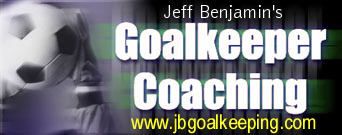
|
"Outstanding keeper instruction. This is a must for goalkeepers and coaches." — Ottawa Internationals S.C. web site, Ottawa, Canada |

|

|
Top |
Next: Psychology
|
I think of them [penalty kicks] as no-lose situations for a goalkeeper. All the pressure is on the field player, who is supposed to score.
-- Brad Friedel, US Men's National Team goalkeeper
| CONTENTS |
|---|
|
Penalty Kicks
Related Blog Entries |
The penalty kick was introduced to soccer in 1891 to combat the growing use of illegal means to prevent goals, particularly by handling the ball. In 1905, the requirement was added that the keeper stay on the goal line until the ball was kicked. This denied the goalkeeper the liberty to advance up to six yards, which resulted in "too many" unsuccessful penalties. In 1929, a prohibition on the keeper's lateral movement was imposed, but was generally ignored. This Restriction was repealed in 1997, in recognition (or resignation?) of the fact that goalkeepers were moving along the line anyway. See the Laws page for more details on penalty kick rules.
As the Laws of the game of soccer currently stand, the goalkeeper must be on the goal line between the goalposts, and may not move forward until the ball is struck. All other players are outside the penalty area, at least ten yards from the ball and behind it. The shooter is identified, the keeper and other players take up their position, the referee signals, and the pressure is on!
For the goalkeeper, a penalty-kick really is a no-lose situation. The keeper is not expected to make the save, so the pressure is on the shooter (the conversion rate of penalty kicks, at all levels of soccer, is 80-90%). But there are tricks a goalkeeper can use to increase their odds of making the save.
The days of guess and dive are over. The goalkeeper should learn to "read" the shooter to try to predict where the ball is going. Combined, perhaps, with scouting reports on shooters, and statistics on general tendencies, a keeper can do much better than 50% in picking direction. Although picking the correct direction doesn't always mean the keeper can make the save, it gives them a head start.
Reading the Shooter
- Watch the shooter's eyes and overall demeanor. Often they will give away small clues before they are ever ready to shoot, like peeking at the corner they are aiming for.
- Watch the approach. Is it straight on, or wide? A very wide approach often indicates the shooter is going towards the opposite corner. A straight-on approach gives fewer clues.
- Watch the plant foot. The ball will go where the plant foot points.
- Watch the hips. The ball goes where the hips point. A "push pass" shot will require the hips to open up in the direction the ball is going.
- Watch the head. If the shooter drops their head low with a big pull-back of the leg, it usually means a cross-body shot. If the head stays up more, it can mean the shooter will stay open to push the ball to the opposite corner.
- Don't react too soon. Use the cues above to predict where the ball might go, and be ready to go that way, but wait a split second to be sure it really is going there. The keeper might think one direction based on the shooter's eyes and approach, but the plant foot and hips may tell a different story just before the ball is struck.
General Tendencies
A study done of all the penalties taken in the 1998 World Cup (including shootouts) noted that almost 70% of the kicks taken went to the opposite side from the kicker's dominant foot (that is, right-footed kickers shot to their left -- keeper's right -- and vice versa). (See Goalkeeper Soccer Training Manual, DiCicco 2000.) This is the natural swing of the foot across the body; it is difficult to put the ball to the other corner with an instep kick. So, if all else fails, the keeper should go right for a right-footed kicker and left for a left footer.Don't Act, React
Also, the goalkeeper should react quickly, but not too quickly. Many penalties, especially at the youth level, are poorly taken, either weakly hit or right down the middle. Often the goalkeeper can easily make the save if they just wait and simply react to the shot.Even "reading the shooter" is a reaction to what the shooter does, and not just guesswork.
A veteran goalkeeper will use all of this, plus their gut feel from years of experience, to try to save a penalty. Brad Friedel says, "Generally there are loads of subtle little hints as to where a player will shoot that they give to the goalkeeper. How he runs up to the soccer ball, how he stands, if his weight's back, if his weight's forward, if he's looking at you the whole time, if he takes a long run as opposed to a short run. There are lots of little differences but you will never really get the gist of it unless you practice a lot of them and figure out what works best for you."
Top |
Next: Psychology
|